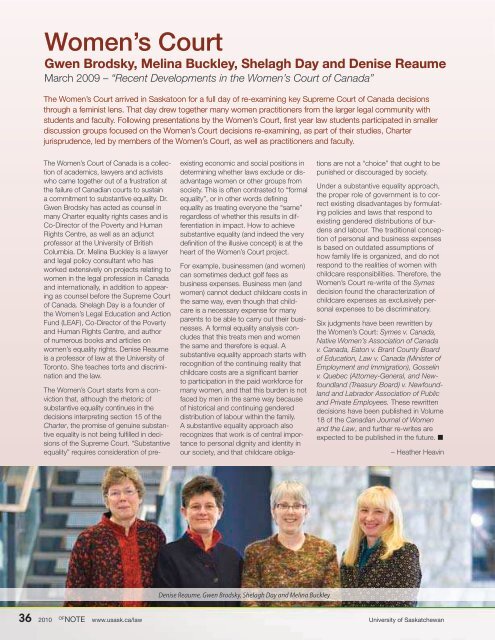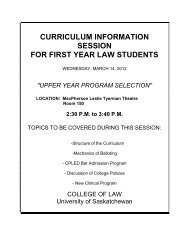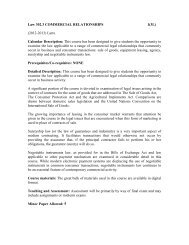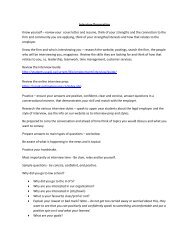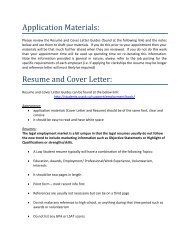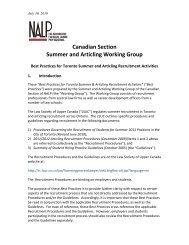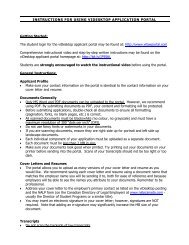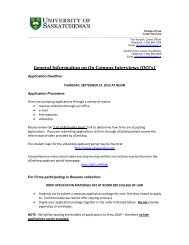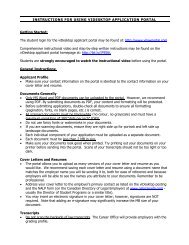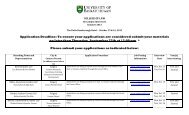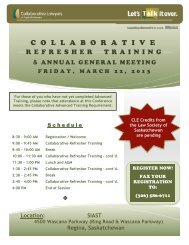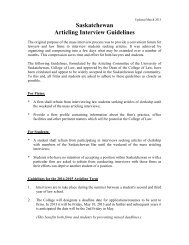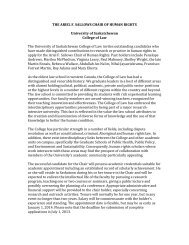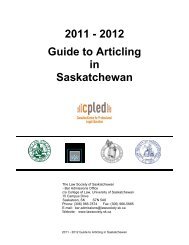2010 of NOTE - College of Law - University of Saskatchewan
2010 of NOTE - College of Law - University of Saskatchewan
2010 of NOTE - College of Law - University of Saskatchewan
Create successful ePaper yourself
Turn your PDF publications into a flip-book with our unique Google optimized e-Paper software.
Women’s Court<br />
Gwen Brodsky, Melina Buckley, Shelagh Day and Denise Reaume<br />
March 2009 – “Recent Developments in the Women’s Court <strong>of</strong> Canada”<br />
The Women’s Court arrived in Saskatoon for a full day <strong>of</strong> re-examining key Supreme Court <strong>of</strong> Canada decisions<br />
through a feminist lens. That day drew together many women practitioners from the larger legal community with<br />
students and faculty. Following presentations by the Women’s Court, first year law students participated in smaller<br />
discussion groups focused on the Women’s Court decisions re-examining, as part <strong>of</strong> their studies, Charter<br />
jurisprudence, led by members <strong>of</strong> the Women’s Court, as well as practitioners and faculty.<br />
The Women’s Court <strong>of</strong> Canada is a collection<br />
<strong>of</strong> academics, lawyers and activists<br />
who came together out <strong>of</strong> a frustration at<br />
the failure <strong>of</strong> Canadian courts to sustain<br />
a commitment to substantive equality. Dr.<br />
Gwen Brodsky has acted as counsel in<br />
many Charter equality rights cases and is<br />
Co-Director <strong>of</strong> the Poverty and Human<br />
Rights Centre, as well as an adjunct<br />
pr<strong>of</strong>essor at the <strong>University</strong> <strong>of</strong> British<br />
Columbia. Dr. Melina Buckley is a lawyer<br />
and legal policy consultant who has<br />
worked extensively on projects relating to<br />
women in the legal pr<strong>of</strong>ession in Canada<br />
and internationally, in addition to appearing<br />
as counsel before the Supreme Court<br />
<strong>of</strong> Canada. Shelagh Day is a founder <strong>of</strong><br />
the Women’s Legal Education and Action<br />
Fund (LEAF), Co-Director <strong>of</strong> the Poverty<br />
and Human Rights Centre, and author<br />
<strong>of</strong> numerous books and articles on<br />
women’s equality rights. Denise Reaume<br />
is a pr<strong>of</strong>essor <strong>of</strong> law at the <strong>University</strong> <strong>of</strong><br />
Toronto. She teaches torts and discrimination<br />
and the law.<br />
The Women’s Court starts from a conviction<br />
that, although the rhetoric <strong>of</strong><br />
substantive equality continues in the<br />
decisions interpreting section 15 <strong>of</strong> the<br />
Charter, the promise <strong>of</strong> genuine substantive<br />
equality is not being fulfilled in decisions<br />
<strong>of</strong> the Supreme Court. “Substantive<br />
equality” requires consideration <strong>of</strong> pre-<br />
existing economic and social positions in<br />
determining whether laws exclude or disadvantage<br />
women or other groups from<br />
society. This is <strong>of</strong>ten contrasted to “formal<br />
equality”, or in other words defining<br />
equality as treating everyone the “same”<br />
regardless <strong>of</strong> whether this results in differentiation<br />
in impact. How to achieve<br />
substantive equality (and indeed the very<br />
definition <strong>of</strong> the illusive concept) is at the<br />
heart <strong>of</strong> the Women’s Court project.<br />
For example, businessmen (and women)<br />
can sometimes deduct golf fees as<br />
business expenses. Business men (and<br />
women) cannot deduct childcare costs in<br />
the same way, even though that childcare<br />
is a necessary expense for many<br />
parents to be able to carry out their businesses.<br />
A formal equality analysis concludes<br />
that this treats men and women<br />
the same and therefore is equal. A<br />
substantive equality approach starts with<br />
recognition <strong>of</strong> the continuing reality that<br />
childcare costs are a significant barrier<br />
to participation in the paid workforce for<br />
many women, and that this burden is not<br />
faced by men in the same way because<br />
<strong>of</strong> historical and continuing gendered<br />
distribution <strong>of</strong> labour within the family.<br />
A substantive equality approach also<br />
recognizes that work is <strong>of</strong> central importance<br />
to personal dignity and identity in<br />
our society, and that childcare obliga-<br />
Denise Reaume, Gwen Brodsky, Shelagh Day and Melina Buckley<br />
tions are not a “choice” that ought to be<br />
punished or discouraged by society.<br />
Under a substantive equality approach,<br />
the proper role <strong>of</strong> government is to correct<br />
existing disadvantages by formulating<br />
policies and laws that respond to<br />
existing gendered distributions <strong>of</strong> burdens<br />
and labour. The traditional conception<br />
<strong>of</strong> personal and business expenses<br />
is based on outdated assumptions <strong>of</strong><br />
how family life is organized, and do not<br />
respond to the realities <strong>of</strong> women with<br />
childcare responsibilities. Therefore, the<br />
Women’s Court re-write <strong>of</strong> the Symes<br />
decision found the characterization <strong>of</strong><br />
childcare expenses as exclusively personal<br />
expenses to be discriminatory.<br />
Six judgments have been rewritten by<br />
the Women’s Court: Symes v. Canada,<br />
Native Women’s Association <strong>of</strong> Canada<br />
v. Canada, Eaton v. Brant County Board<br />
<strong>of</strong> Education, <strong>Law</strong> v. Canada (Minister <strong>of</strong><br />
Employment and Immigration), Gosselin<br />
v. Quebec (Attorney-General, and Newfoundland<br />
(Treasury Board) v. Newfoundland<br />
and Labrador Association <strong>of</strong> Public<br />
and Private Employees. These rewritten<br />
decisions have been published in Volume<br />
18 <strong>of</strong> the Canadian Journal <strong>of</strong> Women<br />
and the <strong>Law</strong>, and further re-writes are<br />
expected to be published in the future. n<br />
– Heather Heavin<br />
36 <strong>2010</strong> <strong>of</strong> 36 <strong>2010</strong> Note www.usask.ca/law <strong>University</strong> <strong>of</strong> <strong>Saskatchewan</strong><br />
<strong>of</strong>Note www.usask.ca/law <strong>University</strong> <strong>of</strong> <strong>Saskatchewan</strong><br />
Successful Aboriginal Summer Student Program Continues<br />
The <strong>College</strong> <strong>of</strong> <strong>Law</strong> has partnered with the Canadian Bar Association<br />
(<strong>Saskatchewan</strong> Branch) and the <strong>Law</strong> Society <strong>of</strong> <strong>Saskatchewan</strong> to establish<br />
a very successful summer employment program for Aboriginal law students.<br />
Now in its third year, the Aboriginal <strong>Law</strong> Student Summer Job Program<br />
connects Aboriginal students with law firms and related organizations.<br />
In 2008, Terri Karpish, Career Development<br />
Officer at the <strong>College</strong>, heard about<br />
a similar program in Alberta. She contacted<br />
Doug Moen, Q.C. then Provincial<br />
Deputy Minister <strong>of</strong> Justice and Deputy<br />
Attorney General <strong>of</strong> <strong>Saskatchewan</strong>, and<br />
at the time Chair <strong>of</strong> the CBA (<strong>Saskatchewan</strong><br />
Branch) Pr<strong>of</strong>essional Image Committee.<br />
He agreed that the program had<br />
merit and the CBA (SK Branch) saw a<br />
need for Aboriginal students to connect<br />
with the legal community. “There was a<br />
risk that these students wouldn’t have<br />
the same opportunity to be part <strong>of</strong> the<br />
legal community that non-Aoriginal students<br />
had and that potential employers<br />
wouldn’t have the opportunity to meet<br />
Aboriginal students. We needed to take<br />
some initiative to get past that.”<br />
The CBA set up the program, contacting<br />
law firms and other potential employers<br />
and obtaining an exemption at<br />
the Human Rights Commission. Doug<br />
and Terri worked closely with the Aboriginal<br />
<strong>Law</strong> Students Association and<br />
its Career Services representative, Carl<br />
Swenson, to raise awareness about the<br />
program and to assist students in the<br />
job application process.<br />
“The success <strong>of</strong> the program is visible<br />
form all sides,” says Moen. “Talking to<br />
participants, it was clear that the experience<br />
is valuable for them. For some<br />
it produced future employment, for<br />
others it provided confidence that they<br />
could be working in any legal environment.<br />
Employers were pleased with<br />
the results. They were seeing people<br />
they were excited about having in the<br />
workplace.”<br />
Kyle Vermette is Metis and was raised<br />
in Prince Albert. He was a summer<br />
student in 2006 then continued at McKercher,<br />
LLP as an articling student and<br />
practices in the area <strong>of</strong> Corporate Commercial<br />
<strong>Law</strong> and Civil Litigation, Health<br />
<strong>Law</strong> and First Nations and Aboriginal<br />
<strong>Law</strong> at the Regina <strong>of</strong>fice. He had applied<br />
at firms the previous summer but<br />
was not hired. He applied under the<br />
program and had many interviews. “Part<br />
<strong>of</strong> it,” he says, “is the confidence even<br />
to apply.” Often students cut themselves<br />
from the process before it even<br />
starts. The program helps them “to see<br />
that they can add some value and be<br />
valuable in the legal community.”<br />
He knew from an academic perspective<br />
he would not be the summer student<br />
they were looking for, but he also knew<br />
he could do good work. “It was just<br />
about getting past that initial point. It’s a<br />
great program. I would not have this job<br />
otherwise,” He has thoroughly enjoyed<br />
his experience with McKercher. “They<br />
always made me feel welcome and it<br />
was immediately comfortable.”<br />
Many different employers participate,<br />
from private firms to government. “It’s<br />
not just going through the motions; it’s<br />
an actual opportunity,” says Vermette.<br />
“They really want to get to know you<br />
and provide you an opportunity to get<br />
some experience in the legal pr<strong>of</strong>ession.”<br />
Seven legal employers were involved<br />
in the initial year, and this year eight<br />
participated. Meghan McCreary handles<br />
recruiting at MacPherson, Leslie &<br />
Tyerman, LLP, which has been involved<br />
since the start <strong>of</strong> the program. This program<br />
fits their goal <strong>of</strong> having more Aboriginal<br />
associates and partners. “First<br />
Nations and Métis people have such<br />
an important role to play in <strong>Saskatchewan</strong>,”<br />
she says. “We recognize it is<br />
fundamental to have Aboriginal people<br />
working in our firm so our clients can be<br />
served by people who are connected to<br />
their communities.”<br />
Michelle Delorme was another successful<br />
participant in the program. She is<br />
a status Indian from the Muskeg Lake<br />
First Nation. She was a summer student<br />
at McKercher in Saskatoon in 2008<br />
and commenced her articling in 2009.<br />
“Definitely the program helped in being<br />
hired,” she says. “The summer was excellent<br />
and I learned so much.” She was<br />
able to see the practical side <strong>of</strong> law,<br />
working with lawyers and seeing what<br />
the job actually entails. “I’m just really<br />
glad I had the opportunity and I feel<br />
more comfortable going into articling.”<br />
She feels the program is a great idea.<br />
“It’s important that it continue, and I’d<br />
like to see other Aboriginal people have<br />
placements with this program.”<br />
For the future, Doug Moen wanted the<br />
program to continue to ensure <strong>Saskatchewan</strong><br />
has more Aboriginal associates,<br />
senior partners and judges. “This<br />
is about the future <strong>of</strong> the legal pr<strong>of</strong>ession<br />
in <strong>Saskatchewan</strong> and we should<br />
never forget that. We have a responsibility<br />
to ensure this pr<strong>of</strong>ession is open<br />
to all young lawyers in the province, and<br />
when it’s called for, we need to take<br />
steps to make sure that is reality.” More<br />
information <strong>of</strong> the program is available<br />
from Terri at the <strong>College</strong>, or Kylie Head,<br />
the Pr<strong>of</strong>essional Image Chair at CBA<br />
(<strong>Saskatchewan</strong> Branch). n<br />
– Terri Karpish<br />
Kyle Vermette<br />
Kylie Head, Micehlle Delorme, Carl Swenson<br />
<strong>College</strong> <strong>of</strong> <strong>Law</strong> Alumni Magazine www.usask.ca/law <strong>of</strong> Note <strong>2010</strong> 37


